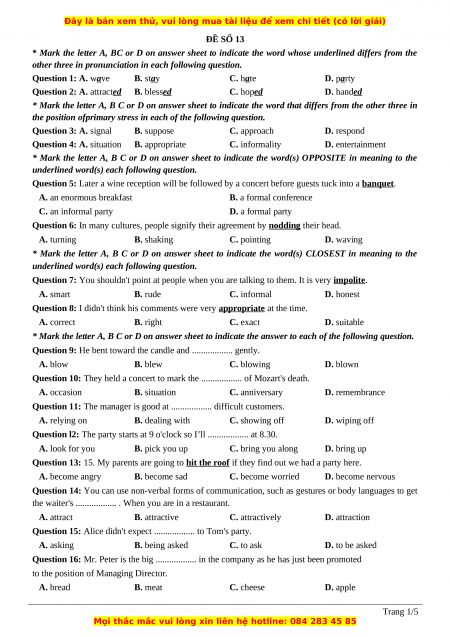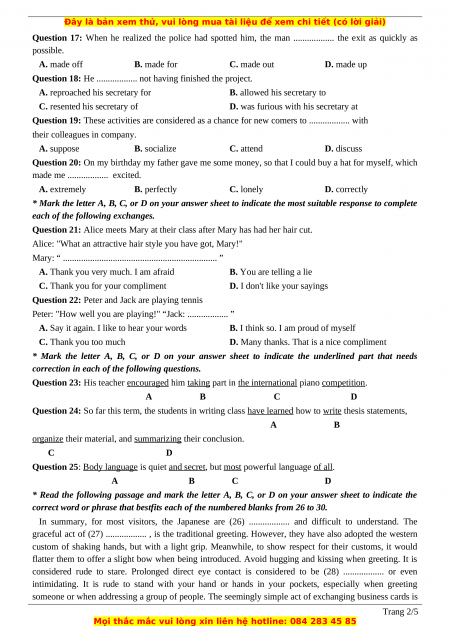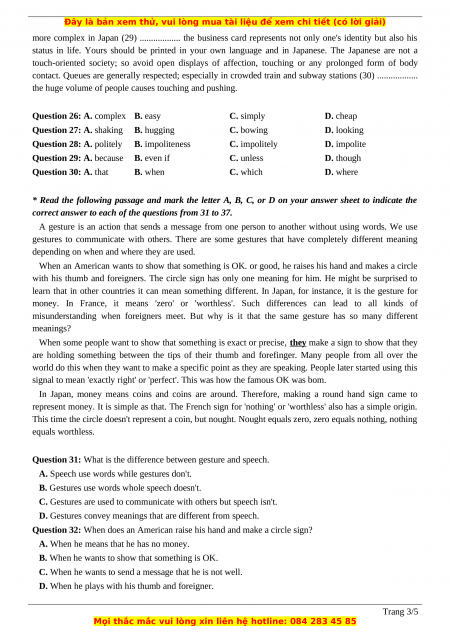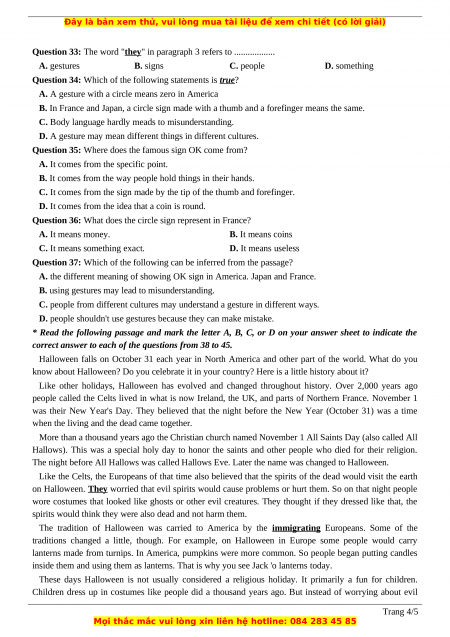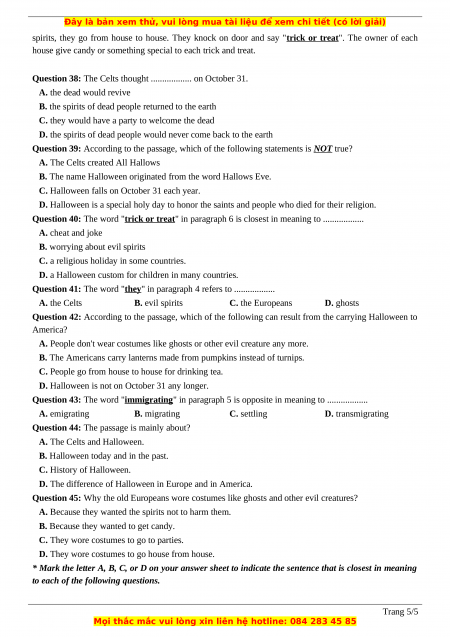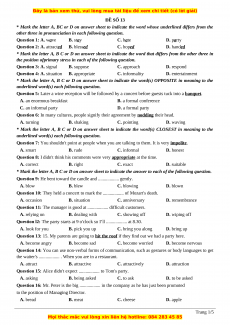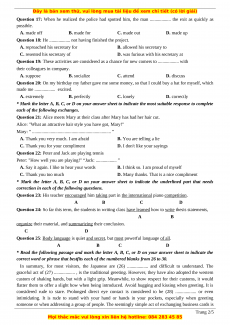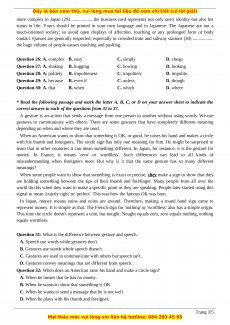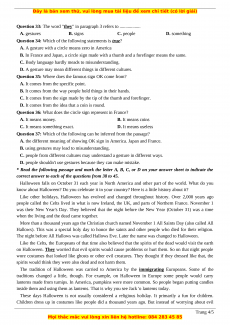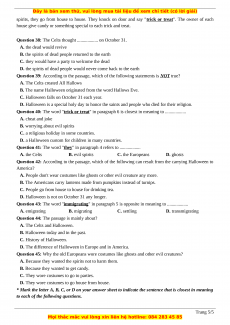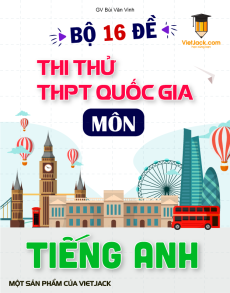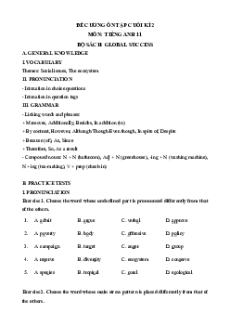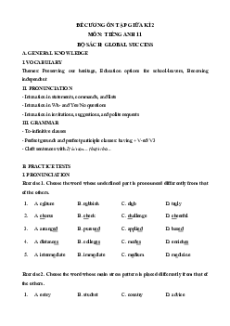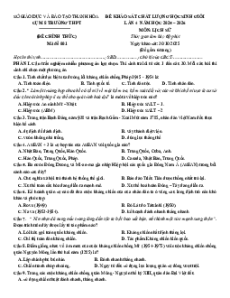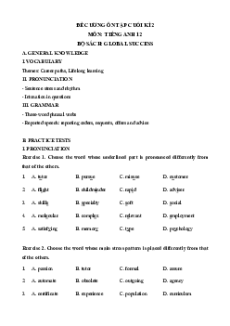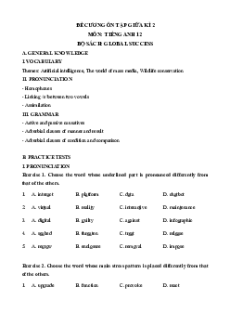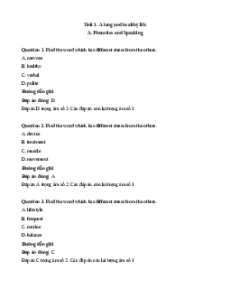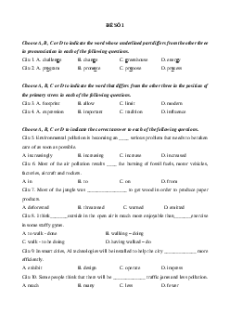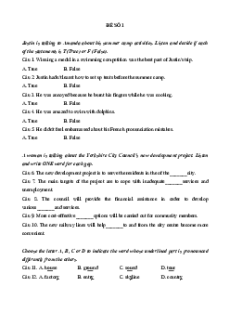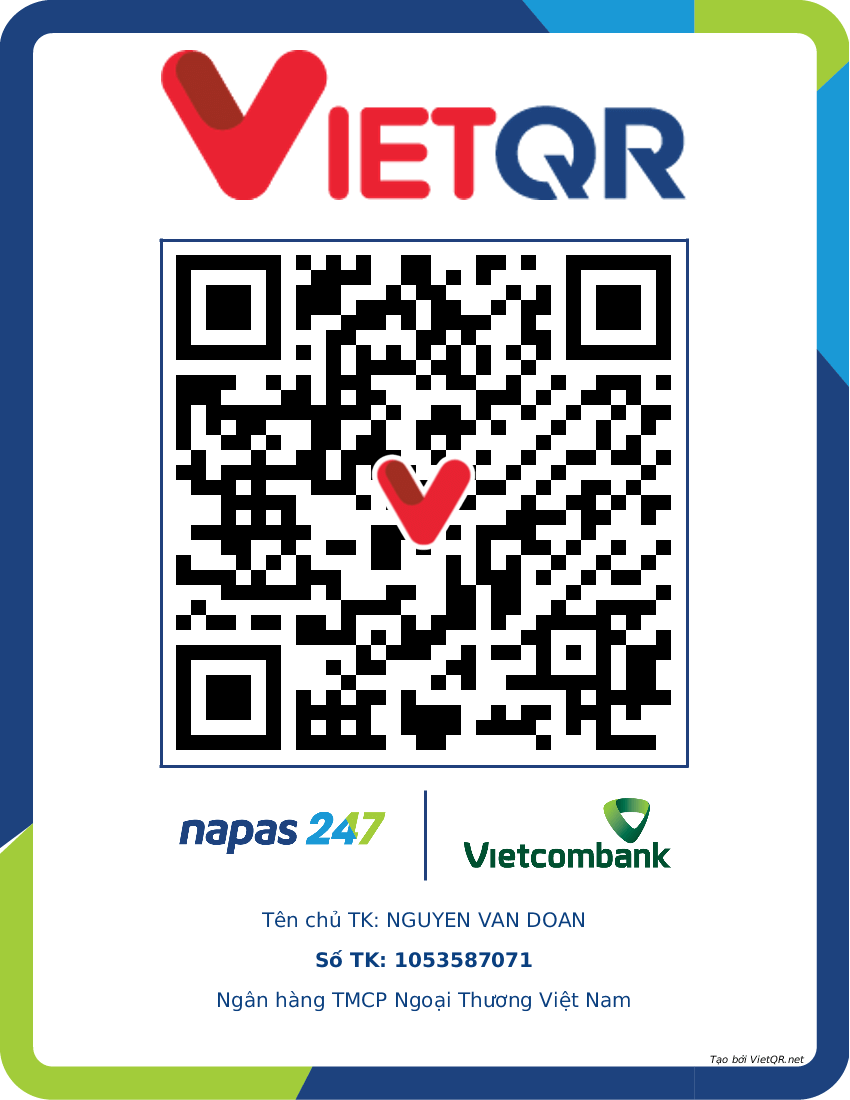ĐỀ SỐ 13
* Mark the letter A, BC or D on answer sheet to indicate the word whose underlined differs from the
other three in pronunciation in each following question.
Question 1: A. wave B. stay C. hate D. party
Question 2: A. attracted
B. blessed C. hoped D. handed
* Mark the letter A, B C or D on answer sheet to indicate the word that differs from the other three in
the position ofprimary stress in each of the following question.
Question 3: A. signal B. suppose C. approach D. respond
Question 4: A. situation B. appropriate C. informality D. entertainment
* Mark the letter A, B C or D on answer sheet to indicate the word(s) OPPOSITE in meaning to the
underlined word(s) each following question.
Question 5: Later a wine reception will be followed by a concert before guests tuck into a banquet.
A. an enormous breakfast B. a formal conference C. an informal party D. a formal party
Question 6: In many cultures, people signify their agreement by nodding their head. A. turning B. shaking C. pointing D. waving
* Mark the letter A, B C or D on answer sheet to indicate the word(s) CLOSEST in meaning to the
underlined word(s) each following question.
Question 7: You shouldn't point at people when you are talking to them. It is very impolite. A. smart B. rude C. informal D. honest
Question 8: I didn't think his comments were very appropriate at the time. A. correct B. right C. exact D. suitable
* Mark the letter A, B C or D on answer sheet to indicate the answer to each of the following question.
Question 9: He bent toward the candle and .................. gently. A. blow B. blew C. blowing D. blown
Question 10: They held a concert to mark the .................. of Mozart's death. A. occasion B. situation C. anniversary D. remembrance
Question 11: The manager is good at .................. difficult customers. A. relying on B. dealing with C. showing off D. wiping off
Question l2: The party starts at 9 o'clock so I’ll .................. at 8.30. A. look for you B. pick you up C. bring you along D. bring up
Question 13: 15. My parents are going to hit the roof if they find out we had a party here. A. become angry B. become sad C. become worried D. become nervous
Question 14: You can use non-verbal forms of communication, such as gestures or body languages to get
the waiter's .................. . When you are in a restaurant. A. attract B. attractive C. attractively D. attraction
Question 15: Alice didn't expect .................. to Tom's party. A. asking B. being asked C. to ask D. to be asked
Question 16: Mr. Peter is the big .................. in the company as he has just been promoted
to the position of Managing Director. A. bread B. meat C. cheese D. apple Trang 1/5
Question 17: When he realized the police had spotted him, the man .................. the exit as quickly as possible. A. made off B. made for C. made out D. made up
Question 18: He .................. not having finished the project.
A. reproached his secretary for
B. allowed his secretary to
C. resented his secretary of
D. was furious with his secretary at
Question 19: These activities are considered as a chance for new comers to .................. with their colleagues in company. A. suppose B. socialize C. attend D. discuss
Question 20: On my birthday my father gave me some money, so that I could buy a hat for myself, which
made me .................. excited. A. extremely B. perfectly C. lonely D. correctly
* Mark the letter A, B, C, or D on your answer sheet to indicate the most suitable response to complete
each of the following exchanges.
Question 21: Alice meets Mary at their class after Mary has had her hair cut.
Alice: "What an attractive hair style you have got, Mary!"
Mary: “ .................................................................... ”
A. Thank you very much. I am afraid
B. You are telling a lie
C. Thank you for your compliment
D. I don't like your sayings
Question 22: Peter and Jack are playing tennis
Peter: "How well you are playing!" “Jack: .................. ”
A. Say it again. I like to hear your words
B. I think so. I am proud of myself C. Thank you too much
D. Many thanks. That is a nice compliment
* Mark the letter A, B, C, or D on your answer sheet to indicate the underlined part that needs
correction in each of the following questions.
Question 23: His teacher encouraged him taking part in the international piano competition. A B C D
Question 24: So far this term, the students in writing class have learned how to write thesis statements, A B
organize their material, and summarizing their conclusion. C D
Question 25: Body language is quiet and secret, but most powerful language of all. A B C D
* Read the following passage and mark the letter A, B, C, or D on your answer sheet to indicate the
correct word or phrase that bestfits each of the numbered blanks from 26 to 30.
In summary, for most visitors, the Japanese are (26) .................. and difficult to understand. The
graceful act of (27) .................. , is the traditional greeting. However, they have also adopted the western
custom of shaking hands, but with a light grip. Meanwhile, to show respect for their customs, it would
flatter them to offer a slight bow when being introduced. Avoid hugging and kissing when greeting. It is
considered rude to stare. Prolonged direct eye contact is considered to be (28) .................. or even
intimidating. It is rude to stand with your hand or hands in your pockets, especially when greeting
someone or when addressing a group of people. The seemingly simple act of exchanging business cards is Trang 2/5
more complex in Japan (29) .................. the business card represents not only one's identity but also his
status in life. Yours should be printed in your own language and in Japanese. The Japanese are not a
touch-oriented society; so avoid open displays of affection, touching or any prolonged form of body
contact. Queues are generally respected; especially in crowded train and subway stations (30) ..................
the huge volume of people causes touching and pushing.
Question 26: A. complex B. easy C. simply D. cheap
Question 27: A. shaking B. hugging C. bowing D. looking
Question 28: A. politely B. impoliteness C. impolitely D. impolite
Question 29: A. because B. even if C. unless D. though
Question 30: A. that B. when C. which D. where
* Read the following passage and mark the letter A, B, C, or D on your answer sheet to indicate the
correct answer to each of the questions from 31 to 37.
A gesture is an action that sends a message from one person to another without using words. We use
gestures to communicate with others. There are some gestures that have completely different meaning
depending on when and where they are used.
When an American wants to show that something is OK. or good, he raises his hand and makes a circle
with his thumb and foreigners. The circle sign has only one meaning for him. He might be surprised to
learn that in other countries it can mean something different. In Japan, for instance, it is the gesture for
money. In France, it means 'zero' or 'worthless'. Such differences can lead to all kinds of
misunderstanding when foreigners meet. But why is it that the same gesture has so many different meanings?
When some people want to show that something is exact or precise, they make a sign to show that they
are holding something between the tips of their thumb and forefinger. Many people from all over the
world do this when they want to make a specific point as they are speaking. People later started using this
signal to mean 'exactly right' or 'perfect'. This was how the famous OK was bom.
In Japan, money means coins and coins are around. Therefore, making a round hand sign came to
represent money. It is simple as that. The French sign for 'nothing' or 'worthless' also has a simple origin.
This time the circle doesn't represent a coin, but nought. Nought equals zero, zero equals nothing, nothing equals worthless.
Question 31: What is the difference between gesture and speech.
A. Speech use words while gestures don't.
B. Gestures use words whole speech doesn't.
C. Gestures are used to communicate with others but speech isn't.
D. Gestures convey meanings that are different from speech.
Question 32: When does an American raise his hand and make a circle sign?
A. When he means that he has no money.
B. When he wants to show that something is OK.
C. When he wants to send a message that he is not well.
D. When he plays with his thumb and foreigner. Trang 3/5
Question 33: The word "they" in paragraph 3 refers to .................. A. gestures B. signs C. people D. something
Question 34: Which of the following statements is true?
A. A gesture with a circle means zero in America
B. In France and Japan, a circle sign made with a thumb and a forefinger means the same.
C. Body language hardly meads to misunderstanding.
D. A gesture may mean different things in different cultures.
Question 35: Where does the famous sign OK come from?
A. It comes from the specific point.
B. It comes from the way people hold things in their hands.
C. It comes from the sign made by the tip of the thumb and forefinger.
D. It comes from the idea that a coin is round.
Question 36: What does the circle sign represent in France? A. It means money. B. It means coins
C. It means something exact. D. It means useless
Question 37: Which of the following can be inferred from the passage?
A. the different meaning of showing OK sign in America. Japan and France.
B. using gestures may lead to misunderstanding.
C. people from different cultures may understand a gesture in different ways.
D. people shouldn't use gestures because they can make mistake.
* Read the following passage and mark the letter A, B, C, or D on your answer sheet to indicate the
correct answer to each of the questions from 38 to 45.
Halloween falls on October 31 each year in North America and other part of the world. What do you
know about Halloween? Do you celebrate it in your country? Here is a little history about it?
Like other holidays, Halloween has evolved and changed throughout history. Over 2,000 years ago
people called the Celts lived in what is now Ireland, the UK, and parts of Northern France. November 1
was their New Year's Day. They believed that the night before the New Year (October 31) was a time
when the living and the dead came together.
More than a thousand years ago the Christian church named November 1 All Saints Day (also called All
Hallows). This was a special holy day to honor the saints and other people who died for their religion.
The night before All Hallows was called Hallows Eve. Later the name was changed to Halloween.
Like the Celts, the Europeans of that time also believed that the spirits of the dead would visit the earth
on Halloween. They worried that evil spirits would cause problems or hurt them. So on that night people
wore costumes that looked like ghosts or other evil creatures. They thought if they dressed like that, the
spirits would think they were also dead and not harm them.
The tradition of Halloween was carried to America by the immigrating Europeans. Some of the
traditions changed a little, though. For example, on Halloween in Europe some people would carry
lanterns made from turnips. In America, pumpkins were more common. So people began putting candles
inside them and using them as lanterns. That is why you see Jack 'o lanterns today.
These days Halloween is not usually considered a religious holiday. It primarily a fun for children.
Children dress up in costumes like people did a thousand years ago. But instead of worrying about evil Trang 4/5
Đề thi thử THPT Quốc Gia môn Tiếng Anh có đáp án ( đề 13 ) - thầy Bùi Văn Vinh
340
170 lượt tải
MUA NGAY ĐỂ XEM TOÀN BỘ TÀI LIỆU
CÁCH MUA:
- B1: Gửi phí vào TK:
1133836868- CT TNHH DAU TU VA DV GD VIETJACK - Ngân hàng MB (QR) - B2: Nhắn tin tới Zalo VietJack Official ( nhấn vào đây ) để xác nhận thanh toán và tải tài liệu - giáo án
Liên hệ ngay Hotline hỗ trợ: 084 283 45 85
Đề thi được cập nhật liên tục trong gói này từ nay đến hết tháng 6/2023. Chúng tôi đảm bảo đủ số lượng đề đã cam kết hoặc có thể nhiều hơn, tất cả có BẢN WORD, LỜI GIẢI CHI TIẾT và tải về dễ dàng.
Để tải tài liệu gốc về máy bạn click vào nút Tải Xuống ở trên!
Thuộc bộ (mua theo bộ để tiết kiệm hơn):
- Các đề thi được chọn lọc từ các trường Chuyên và Sở Giáo dục cả nước. Đảm bảo chất lượng, cấu trúc bám sát nhất với kì thì TN THPT 2023 môn Tiếng Anh.
- File word có lời giải chi tiết 100%.
- Đề thi mới sẽ được cập nhật tại gói này đến sát kì thi TN THPT 2023
- Mua trọn bộ sẽ tiết kiệm hơn tải lẻ 50%.
Đánh giá
4.6 / 5(340 )5
4
3
2
1
Trọng Bình
Tài liệu hay
Giúp ích cho tôi rất nhiều
Duy Trần
Tài liệu chuẩn
Rất thích tài liệu bên VJ soạn (bám sát chương trình dạy)
TÀI LIỆU BỘ BÁN CHẠY MÔN Tiếng Anh
Xem thêmTÀI LIỆU BỘ BÁN CHẠY Lớp 12
Xem thêmTài liệu bộ mới nhất

Đây là bản xem thử, vui lòng mua tài liệu để xem chi tiết (có lời giải)
ĐỀ SỐ 13
* Mark the letter A, BC or D on answer sheet to indicate the word whose underlined differs from the
other three in pronunciation in each following question.
Question 1: A. wave B. stay C. hate D. party
Question 2: A. attracted B. blessed C. hoped D. handed
* Mark the letter A, B C or D on answer sheet to indicate the word that differs from the other three in
the position ofprimary stress in each of the following question.
Question 3: A. signal B. suppose C. approach D. respond
Question 4: A. situation B. appropriate C. informality D. entertainment
* Mark the letter A, B C or D on answer sheet to indicate the word(s) OPPOSITE in meaning to the
underlined word(s) each following question.
Question 5: Later a wine reception will be followed by a concert before guests tuck into a banquet.
A. an enormous breakfast B. a formal conference
C. an informal party D. a formal party
Question 6: In many cultures, people signify their agreement by nodding their head.
A. turning B. shaking C. pointing D. waving
* Mark the letter A, B C or D on answer sheet to indicate the word(s) CLOSEST in meaning to the
underlined word(s) each following question.
Question 7: You shouldn't point at people when you are talking to them. It is very impolite.
A. smart B. rude C. informal D. honest
Question 8: I didn't think his comments were very appropriate at the time.
A. correct B. right C. exact D. suitable
* Mark the letter A, B C or D on answer sheet to indicate the answer to each of the following question.
Question 9: He bent toward the candle and .................. gently.
A. blow B. blew C. blowing D. blown
Question 10: They held a concert to mark the .................. of Mozart's death.
A. occasion B. situation C. anniversary D. remembrance
Question 11: The manager is good at .................. difficult customers.
A. relying on B. dealing with C. showing off D. wiping off
Question l2: The party starts at 9 o'clock so I’ll .................. at 8.30.
A. look for you B. pick you up C. bring you along D. bring up
Question 13: 15. My parents are going to hit the roof if they find out we had a party here.
A. become angry B. become sad C. become worried D. become nervous
Question 14: You can use non-verbal forms of communication, such as gestures or body languages to get
the waiter's .................. . When you are in a restaurant.
A. attract B. attractive C. attractively D. attraction
Question 15: Alice didn't expect .................. to Tom's party.
A. asking B. being asked C. to ask D. to be asked
Question 16: Mr. Peter is the big .................. in the company as he has just been promoted
to the position of Managing Director.
A. bread B. meat C. cheese D. apple
Trang 1/5
Mọi thắc mắc vui lòng xin liên hệ hotline: 084 283 45 85

Đây là bản xem thử, vui lòng mua tài liệu để xem chi tiết (có lời giải)
Question 17: When he realized the police had spotted him, the man .................. the exit as quickly as
possible.
A. made off B. made for C. made out D. made up
Question 18: He .................. not having finished the project.
A. reproached his secretary for B. allowed his secretary to
C. resented his secretary of D. was furious with his secretary at
Question 19: These activities are considered as a chance for new comers to .................. with
their colleagues in company.
A. suppose B. socialize C. attend D. discuss
Question 20: On my birthday my father gave me some money, so that I could buy a hat for myself, which
made me .................. excited.
A. extremely B. perfectly C. lonely D. correctly
* Mark the letter A, B, C, or D on your answer sheet to indicate the most suitable response to complete
each of the following exchanges.
Question 21: Alice meets Mary at their class after Mary has had her hair cut.
Alice: "What an attractive hair style you have got, Mary!"
Mary: “ .................................................................... ”
A. Thank you very much. I am afraid B. You are telling a lie
C. Thank you for your compliment D. I don't like your sayings
Question 22: Peter and Jack are playing tennis
Peter: "How well you are playing!" “Jack: .................. ”
A. Say it again. I like to hear your words B. I think so. I am proud of myself
C. Thank you too much D. Many thanks. That is a nice compliment
* Mark the letter A, B, C, or D on your answer sheet to indicate the underlined part that needs
correction in each of the following questions.
Question 23: His teacher encouraged him taking part in the international piano competition.
A B C D
Question 24: So far this term, the students in writing class have learned how to write thesis statements,
A B
organize their material, and summarizing their conclusion.
C D
Question 25: Body language is quiet and secret, but most powerful language of all.
A B C D
* Read the following passage and mark the letter A, B, C, or D on your answer sheet to indicate the
correct word or phrase that bestfits each of the numbered blanks from 26 to 30.
In summary, for most visitors, the Japanese are (26) .................. and difficult to understand. The
graceful act of (27) .................. , is the traditional greeting. However, they have also adopted the western
custom of shaking hands, but with a light grip. Meanwhile, to show respect for their customs, it would
flatter them to offer a slight bow when being introduced. Avoid hugging and kissing when greeting. It is
considered rude to stare. Prolonged direct eye contact is considered to be (28) .................. or even
intimidating. It is rude to stand with your hand or hands in your pockets, especially when greeting
someone or when addressing a group of people. The seemingly simple act of exchanging business cards is
Trang 2/5
Mọi thắc mắc vui lòng xin liên hệ hotline: 084 283 45 85

Đây là bản xem thử, vui lòng mua tài liệu để xem chi tiết (có lời giải)
more complex in Japan (29) .................. the business card represents not only one's identity but also his
status in life. Yours should be printed in your own language and in Japanese. The Japanese are not a
touch-oriented society; so avoid open displays of affection, touching or any prolonged form of body
contact. Queues are generally respected; especially in crowded train and subway stations (30) ..................
the huge volume of people causes touching and pushing.
Question 26: A. complex B. easy C. simply D. cheap
Question 27: A. shaking B. hugging C. bowing D. looking
Question 28: A. politely B. impoliteness C. impolitely D. impolite
Question 29: A. because B. even if C. unless D. though
Question 30: A. that B. when C. which D. where
* Read the following passage and mark the letter A, B, C, or D on your answer sheet to indicate the
correct answer to each of the questions from 31 to 37.
A gesture is an action that sends a message from one person to another without using words. We use
gestures to communicate with others. There are some gestures that have completely different meaning
depending on when and where they are used.
When an American wants to show that something is OK. or good, he raises his hand and makes a circle
with his thumb and foreigners. The circle sign has only one meaning for him. He might be surprised to
learn that in other countries it can mean something different. In Japan, for instance, it is the gesture for
money. In France, it means 'zero' or 'worthless'. Such differences can lead to all kinds of
misunderstanding when foreigners meet. But why is it that the same gesture has so many different
meanings?
When some people want to show that something is exact or precise, they make a sign to show that they
are holding something between the tips of their thumb and forefinger. Many people from all over the
world do this when they want to make a specific point as they are speaking. People later started using this
signal to mean 'exactly right' or 'perfect'. This was how the famous OK was bom.
In Japan, money means coins and coins are around. Therefore, making a round hand sign came to
represent money. It is simple as that. The French sign for 'nothing' or 'worthless' also has a simple origin.
This time the circle doesn't represent a coin, but nought. Nought equals zero, zero equals nothing, nothing
equals worthless.
Question 31: What is the difference between gesture and speech.
A. Speech use words while gestures don't.
B. Gestures use words whole speech doesn't.
C. Gestures are used to communicate with others but speech isn't.
D. Gestures convey meanings that are different from speech.
Question 32: When does an American raise his hand and make a circle sign?
A. When he means that he has no money.
B. When he wants to show that something is OK.
C. When he wants to send a message that he is not well.
D. When he plays with his thumb and foreigner.
Trang 3/5
Mọi thắc mắc vui lòng xin liên hệ hotline: 084 283 45 85

Đây là bản xem thử, vui lòng mua tài liệu để xem chi tiết (có lời giải)
Question 33: The word "they" in paragraph 3 refers to ..................
A. gestures B. signs C. people D. something
Question 34: Which of the following statements is true?
A. A gesture with a circle means zero in America
B. In France and Japan, a circle sign made with a thumb and a forefinger means the same.
C. Body language hardly meads to misunderstanding.
D. A gesture may mean different things in different cultures.
Question 35: Where does the famous sign OK come from?
A. It comes from the specific point.
B. It comes from the way people hold things in their hands.
C. It comes from the sign made by the tip of the thumb and forefinger.
D. It comes from the idea that a coin is round.
Question 36: What does the circle sign represent in France?
A. It means money. B. It means coins
C. It means something exact. D. It means useless
Question 37: Which of the following can be inferred from the passage?
A. the different meaning of showing OK sign in America. Japan and France.
B. using gestures may lead to misunderstanding.
C. people from different cultures may understand a gesture in different ways.
D. people shouldn't use gestures because they can make mistake.
* Read the following passage and mark the letter A, B, C, or D on your answer sheet to indicate the
correct answer to each of the questions from 38 to 45.
Halloween falls on October 31 each year in North America and other part of the world. What do you
know about Halloween? Do you celebrate it in your country? Here is a little history about it?
Like other holidays, Halloween has evolved and changed throughout history. Over 2,000 years ago
people called the Celts lived in what is now Ireland, the UK, and parts of Northern France. November 1
was their New Year's Day. They believed that the night before the New Year (October 31) was a time
when the living and the dead came together.
More than a thousand years ago the Christian church named November 1 All Saints Day (also called All
Hallows). This was a special holy day to honor the saints and other people who died for their religion.
The night before All Hallows was called Hallows Eve. Later the name was changed to Halloween.
Like the Celts, the Europeans of that time also believed that the spirits of the dead would visit the earth
on Halloween. They worried that evil spirits would cause problems or hurt them. So on that night people
wore costumes that looked like ghosts or other evil creatures. They thought if they dressed like that, the
spirits would think they were also dead and not harm them.
The tradition of Halloween was carried to America by the immigrating Europeans. Some of the
traditions changed a little, though. For example, on Halloween in Europe some people would carry
lanterns made from turnips. In America, pumpkins were more common. So people began putting candles
inside them and using them as lanterns. That is why you see Jack 'o lanterns today.
These days Halloween is not usually considered a religious holiday. It primarily a fun for children.
Children dress up in costumes like people did a thousand years ago. But instead of worrying about evil
Trang 4/5
Mọi thắc mắc vui lòng xin liên hệ hotline: 084 283 45 85

Đây là bản xem thử, vui lòng mua tài liệu để xem chi tiết (có lời giải)
spirits, they go from house to house. They knock on door and say "trick or treat". The owner of each
house give candy or something special to each trick and treat.
Question 38: The Celts thought .................. on October 31.
A. the dead would revive
B. the spirits of dead people returned to the earth
C. they would have a party to welcome the dead
D. the spirits of dead people would never come back to the earth
Question 39: According to the passage, which of the following statements is NOT true?
A. The Celts created All Hallows
B. The name Halloween originated from the word Hallows Eve.
C. Halloween falls on October 31 each year.
D. Halloween is a special holy day to honor the saints and people who died for their religion.
Question 40: The word "trick or treat" in paragraph 6 is closest in meaning to ..................
A. cheat and joke
B. worrying about evil spirits
C. a religious holiday in some countries.
D. a Halloween custom for children in many countries.
Question 41: The word "they" in paragraph 4 refers to ..................
A. the Celts B. evil spirits C. the Europeans D. ghosts
Question 42: According to the passage, which of the following can result from the carrying Halloween to
America?
A. People don't wear costumes like ghosts or other evil creature any more.
B. The Americans carry lanterns made from pumpkins instead of turnips.
C. People go from house to house for drinking tea.
D. Halloween is not on October 31 any longer.
Question 43: The word "immigrating" in paragraph 5 is opposite in meaning to ..................
A. emigrating B. migrating C. settling D. transmigrating
Question 44: The passage is mainly about?
A. The Celts and Halloween.
B. Halloween today and in the past.
C. History of Halloween.
D. The difference of Halloween in Europe and in America.
Question 45: Why the old Europeans wore costumes like ghosts and other evil creatures?
A. Because they wanted the spirits not to harm them.
B. Because they wanted to get candy.
C. They wore costumes to go to parties.
D. They wore costumes to go house from house.
* Mark the letter A, B, C, or D on your answer sheet to indicate the sentence that is closest in meaning
to each of the following questions.
Trang 5/5
Mọi thắc mắc vui lòng xin liên hệ hotline: 084 283 45 85
